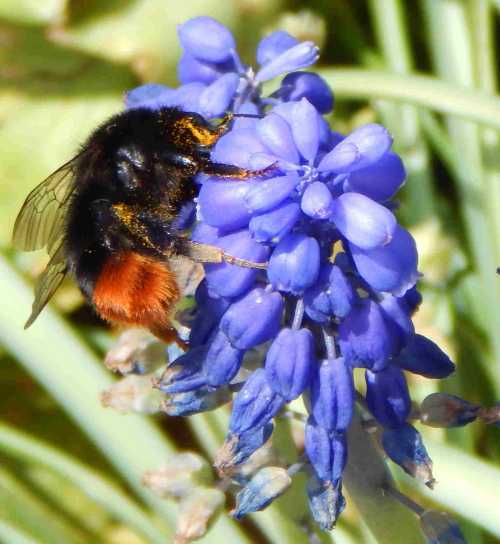Bees Love Lavender
Bees love lavender. This fragrant herb provides nectar for foraging bees from spring and through summer. From personal observation, they seem to like both English lavender and French lavender and hybrids.
However, although it appears honey bees like lavender (and will certainly visit it), research suggests it is more popular with bumble bees than honey bees.
Why lavender is more popular with bumble bees than honey bees
Research from the University of Sussex1 found that bumble bees, with their longer tongues, are better adapted than honey bees to extract the nectar from the tubular shaped flowers.
For example, Grosso lavender flowers were approximately 7.5mm deep. Honey bee tongues were 6-7mm long whereas bumble bee tongues were 7.5-9mm long.
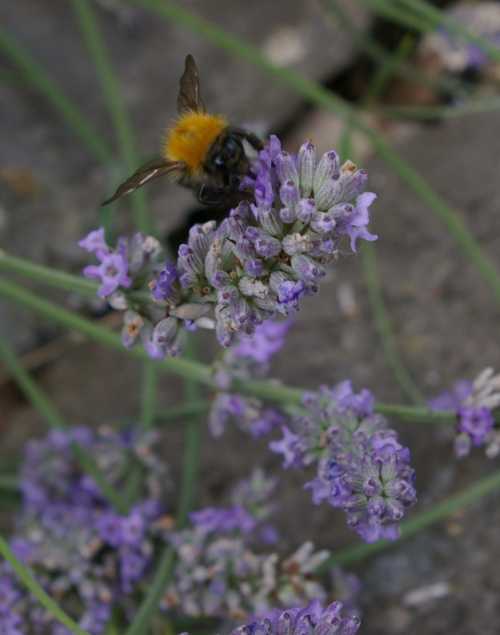 Bumble bees can quickly extract the nectar from lavender flowers because of their long tongues.
Bumble bees can quickly extract the nectar from lavender flowers because of their long tongues.What does this mean in practice?
It basically means that it takes less effort for a bumble bee to feed on lavender, than it takes for a honey bee.
As a result of having longer tongues, researchers observed that a bumble bee needs only 1.1 - 1.4 seconds to extract nectar from a lavender flower.
In contrast, the honey bee needs to push its head further into the flower in order to reach the nectar, resulting in the bee having to spend about 3.5 seconds on a flower.
(Although note, all members of the Apidae bee family which includes both honey and bumble bees, are scientifically categorised as being 'long-tongued').
A couple of seconds difference may not seem like much, but multiplied over several thousands of flower visits, the difference becomes very significant.
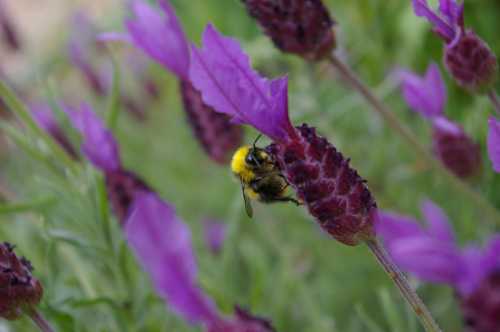 Bumble bee on French lavender.
Bumble bee on French lavender.The researchers found that on average, a lavender flower contained only 0.02 micro-litres of nectar.
Given that a honey bee can hold 50 micro-litres in its honey stomach, a bee would need to visit many flowers - about 2,500 in order to fill its honey stomach before returning to the colony.
At a rate o 3.5 seconds per flower, I calculate that it would take a honey bee 8,750 seconds to fill up its honey stomach if it foraged only from lavender flowers.
In other words, that's 145.8 minutes, or 2.43 hours.
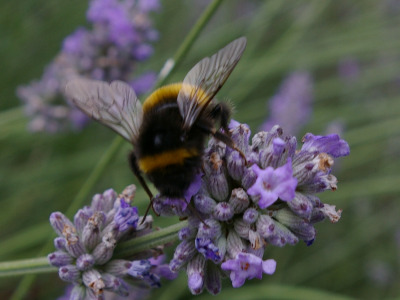 Bumble bee foraging on English lavender.
Bumble bee foraging on English lavender.While bumble bees make a beeline for lavender, honey bees prefer to forage on borage
In a garden full of flowers, different bee species will always choose to forage from those offering the most reward for them, but this depends on the species of bee and on the flowers available.
It's clear that some flowers are more attractive for particular bee species than other flowers. For example it's well known that borage is another favourite herb for bees.
However, in research, again from Sussex University, when both borage and lavender were available to bees, the bumble bees favoured lavender, whereas the honey bees mostly visited the borage.
In fact, they counted 10 times as many bumble bees as honey bees on the lavender, where as far more honey bees were observed visiting borage than bumble bees2.
Certainly in my garden, I mostly see bumble bees on my lavender and the occasional blue mason bee, particularly in spring.
Growing lavender for bees
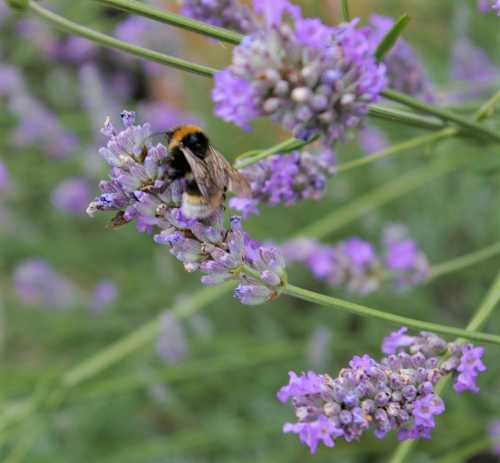 Bumble bees love the lavender in my garden.
Bumble bees love the lavender in my garden.Lavender needs a sunny spot in well-drained soil, and will thrive quite well in drought conditions.
Lavender also looks great in pots on the patio, but despite being fairly drought tolerant, they could dry out in containers and so will need to be watered in hot, dry spells.
However, one advantage of growing in pots is that if you have a greenhouse, you can pop the plants inside to shelter in winter if necessary.
We lost a large lavender shrub one winter thanks to particularly heavy snowfall. It was outdoors in a fairly exposed position in the garden.
You can grow lavender from seed or from cuttings. Softwood cuttings can be taken early to mid-summer. Hardwood cuttings can be taken from late autumn after flowering. It's best to take multiple cuttings since they may not all take.
If you would like to keep the plant compact, prune after flowering.
I have tended to leave the flowers in place until the following year, so that the birds can feed from the seeds, although the plant can become a bit untidy in appearance.

Want to grow lavender for bees? Lavender varieties to try...
Bees like lavender of many varieties including hybrids. Here are a few you could try:
English lavender:
- Lavandula angustifolia 'Imperial Gem' - English lavender 'Imperial Gem'
- Lavandula angustifolia 'Loddon Pink' - English lavender 'Loddon Pink'
- Lavandula angustifolia 'Lullaby Blue' - English lavender 'Lullaby Blue'
- Lavandula angustifolia 'Munstead' - English lavender 'Munstead'
- Lavandula angustifolia 'Nana Alba' - dwarf white English lavender
- Lavandula angustifolia 'Wendy Carlile' - English lavender 'Wendy Carlile'
- Lavandula angustifolia 'Beechwood Blue' - English lavender 'Beechwood Blue'
- Lavandula angustifolia 'Hidcote' - English lavender 'Hidcote'
French lavender:
- Lavandula stoechas subsp. stoechas f. leucantha - white-flowered French lavender
- Lavandula stoechas subsp. stoechas 'Provençal' - French lavender 'Provençal'
- Lavandula stoechas subsp. stoechas f. rosea 'Kew Red' - French lavender 'Kew Red'
- Lavandula stoechas 'Spring-break Princess' - French lavender 'Spring-break Princess'
- Lavandula stoechas subsp. stoechas f. leucantha 'Snowman' - white-flowered French lavender 'Snowman'
- Lavandula stoechas Coco Deep Pink (Coco Series) - French lavender [Coco Deep Pink]
- Lavandula stoechas subsp. stoechas - French lavender
More lavenders to try:
- Lavandula × intermedia 'Edelweiss'
- Lavandula angustifolia 'Purple Treasure'
- Lavandula 'Pretty Polly'
- Lavandula angustifolia 'Backhouse Purple'
- Lavandula × intermedia 'Anniversary Bouquet'
- Lavandula angustifolia 'Purity'
References
1. ‘Longer tongues and swifter handling: why more bumble bees (Bombus spp.) than honey bees (Apis mellifera) forage on lavender (Lavandula spp.)’, Balfour, N. J.; Garbuzov, M.; Ratnieks, F. L.W., in Ecological Entomology (online)
2. Quantifying variation among garden plants in attractiveness to bees and other flower-visiting insects’, Functional Ecology, (October 2013). Functional Ecology is a journal of the British Ecological Society.
More articles about bees and plants
- Bees And Brambles: The Value Of Brambles To Bees Also known as blackberry bush, research shows each bramble flower secretes lots of nectar for bees!
- Bees And Bee Balm Bee Balm (Monarda) - also known as 'Bergamot) is a herbaceous perennial which is attractive for bees.
- 30 Fantastic Garden Flowers For Bees Flowering plant recommendations for the perfect bee garden.
- Bees love lupins – but so do slugs and snails, so what can you do? Here's a way to protect your lupins....using garlic!
- Plant Oregano For Bees (Marjoram) It's rich in nectar, and attracts bees, butterflies and hoverflies in summer. Here's how to plant it.
- Fennel Pollen And Nectar Bees love fennel! How to grow it, gather it, and the many uses of fennel seeds and pollen.
If you found this page helpful or interesting, I'd really be grateful if you would share it with others - if not this page, perhaps another, such as Gardening For Bees.
Thank you so much :) .
